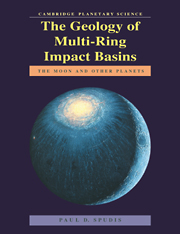Book contents
- Frontmatter
- Contents
- Preface
- 1 The multi-ring basin problem
- 2 From crater to basin
- 3 The ‘archetype’ basin: Orientale
- 4 An ancient basin: Nectaris
- 5 A modified basin: Crisium
- 6 A transitional basin: Serenitatis
- 7 The largest basin: Imbrium
- 8 Geological processes in the formation of lunar basins
- 9 Multi-ring basins on the terrestrial planets
- 10 Multi-ring basins and planetary evolution
- References
- Index
Preface
Published online by Cambridge University Press: 12 October 2009
- Frontmatter
- Contents
- Preface
- 1 The multi-ring basin problem
- 2 From crater to basin
- 3 The ‘archetype’ basin: Orientale
- 4 An ancient basin: Nectaris
- 5 A modified basin: Crisium
- 6 A transitional basin: Serenitatis
- 7 The largest basin: Imbrium
- 8 Geological processes in the formation of lunar basins
- 9 Multi-ring basins on the terrestrial planets
- 10 Multi-ring basins and planetary evolution
- References
- Index
Summary
Multi-ring basins are the largest impact craters on Solar System bodies. They form in the earliest stages of planetary history by the collision of asteroid-sized bodies with planets and affect the subsequent evolution of these latter objects in many profound ways. Many scientists have expended great effort in attempting to understand these features; a casual glance at the literature of planetary science over the last 30 years reveals no less than several hundred entries dealing with some facet of multiring basins.
Planetary scientists studying the problem of multi-ring basins approach it from many different directions. Some are physicists, describing the mechanics of basin formation on the basis of known theory. Other workers make geological maps from photographs, searching for clues to the processes that have shaped the surface of the planet. Still others study the chemistry and mineralogy of terrestrial and lunar samples, using the rock record to reconstruct the physical extremes of heat and pressure produced during large impacts. The basin problem is multi-disciplinary; answers to the many questions raised by these features require knowledge from geology, chemistry, physics, and other fields of study. No one person has the expertise to understand all aspects of the basin problem: So why this book?
The only other book available on the problems posed by basins is the proceedings of a topical conference held at the Lunar and Planetary Institute, Houston, in November, 1980 (Multi-ring Basins: Formation and Evolution, P.H. Schultz and R.B. Merrill, editors, Supplement 15 of Geochimica et Cosmochimica Acta, Pergamon Press, New York, 1981).
- Type
- Chapter
- Information
- The Geology of Multi-Ring Impact BasinsThe Moon and Other Planets, pp. xi - xivPublisher: Cambridge University PressPrint publication year: 1993

